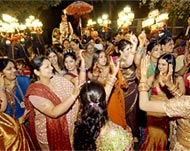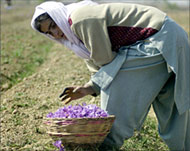Story of civilisation in a dot
It is a small dot that tells a big story about India. Tilak or the vermilion dot put on the forehead, originally a Hindu religious symbol, is the country’s most widely accepted cultural insignia.

Its appeal goes beyond age, gender, ideology and even religion.
To the scriptural scientist, the area where tilak is placed-between the eyebrows-is the “door to spiritual awakening.”
“Tilak is an imprint of supreme wisdom which is why all Hindu deities are shown wearing it and the devotees put it on to express their spiritual aspirations,” said Brajendra Nandan Das, Delhi spokesman of the International Society for Krishna Conscious or ISKCON.
The shape and size of the tilak, however, varies from sect to sect. According to Swami BS Tirtha Goswami, head of the Kolkatta-based Sri Gaurang Ashram, “there are as many shapes as the Upanishads (a set of 108 religious books) although only the main three tilaks, worn by the Hindu trinity of Brahma, Vishnu and Shiva, are in vogue.”
Spiritual protection
According to the scriptures, the tilak or bindi is supposed to “protect and purify the mind as well as the body” and devout Hindus put small dots all over themselves and their deities as they chant the recommended ‘mantras’ or verses during morning prayers.
Hindu priest Mukesh Brijwasi said: “I feel that the tilak has become a part of me because I have been putting it almost as a reflex for over twenty years. I would feel incomplete and vacant if I didn’t put it.”
 |
|
More and more single women are |
Like all Krishna devotees, Bjijwasi puts on a tilak made out of gopichandan, a special clay that is only found in Vrindavana, one of the most holy Hindu places.
According to Krishna traditions, Krishna, the supreme Hindu deity, is said to have spent childhood and adolescence there in the company of gopis or consorts.
While a clay tilak is usually put by the followers of Vishnu, one made of ash is the signature of those who believe in Shiva.
Herbal variety
And consumers may even be able to buy a herbal bindi sticker soon as Shahnaz Herbals, one of India’s most popular herbal beauty product manufacturer, is currently researching the product.
“The traditional bindi is messy because it gets smudged with sweat and the stick-on plastic bindis that have been in vogue for nearly two decades are harmful to the skin because of the use of chemical gum,” said Elle Bhatia, a Shahnaz Herbals sales executive.
Among ordinary people, the circular red tilak, made out of the flowers of saffron, powder of sandalwood and turmeric, is the most popular. The colour red symbolises vitality while yellow sunshine, making the tilak popular during celebrations including birth, marriage and religious festivals.
Fashion statement
Elaborate ceremonies are conducted when the tilak is to be worn, especially during marriage. Once it is placed on a bride’s head, it is called tikka and bindi, Hindi words for dot or circle.
 |
|
Saffron flowers are used to mix |
According to custom in many parts of India, bindi is an adornment prohibited to unmarried women and widows but most modern women ignore this rule.
“I have never thought about its religious or social symbolism and in my own family I have defended a widow wearing it,” said Pramila Pande of the women’s wing of the Communist Party of India.
Pande is from Maharashtra where even school girls wear bindis.
“The bindi’s appeal has obviously transcended religious or social symbolism because even Muslim and Sikh women wear it,” she said.
Social activist Nafisa Ali and television anchorwoman Ashwani Kaur are among the more notable non-Hindu women who sport the bindi. Fashion designers have increasingly used it for their latest looks.
Appeal in West
Fashion commentator and writer Asmita Aggarwal wrote that the bindi, “is an ideal accessory with Indian outfits (even) Madonna has popularized it even in the west.”
Western interest in the bindi is evident in its sales to foreign tourists in India.
“After the colourful glass bangles, bindi is the hottest selling item in my shop which gets more foreigners than Indians,” said Indra Vyas, who owns a costume jewellery shop in Delhi.